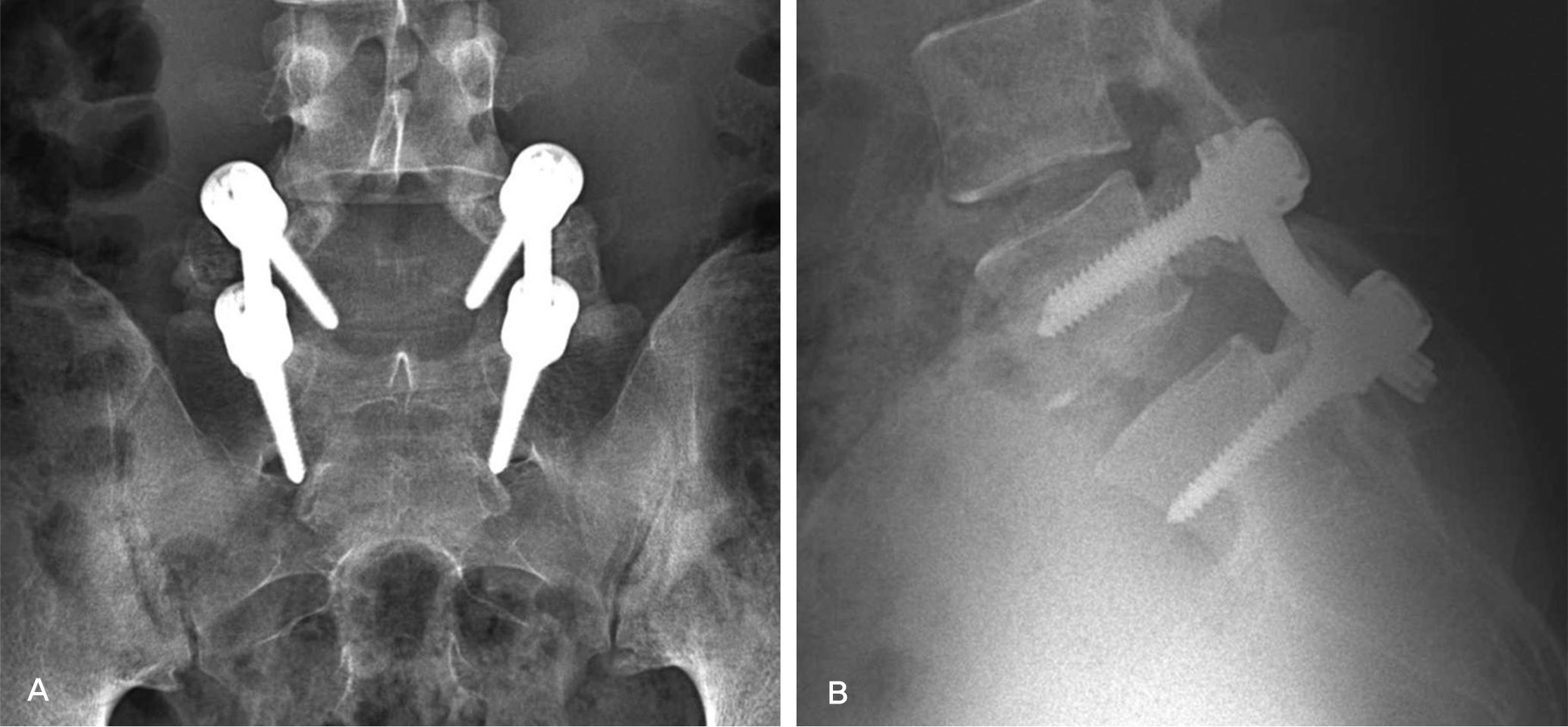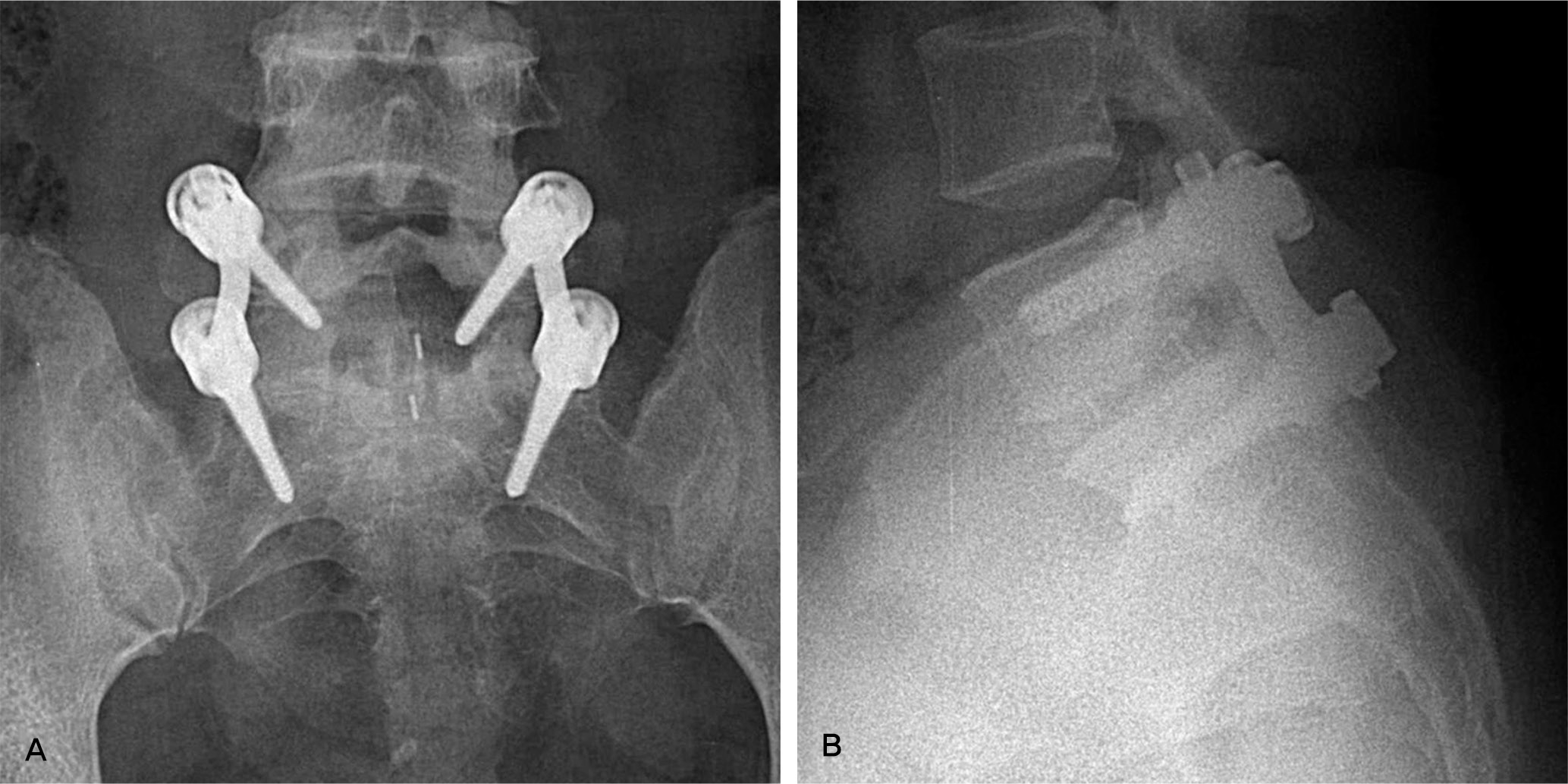Abstract
Objectives
The authors found that problems such as axial pain, donor site pain, loss of reduction, loosening or failure of fixation materials occurred relatively frequently after posterolateral fusion. For this, we had views on the ideas that the problems could be improved by an operation that fused vertebral bodies. Furthermore, we performed posterior lumbar interbody fusion and wanted to know the results.
Summary of Literature Review
We performed posterior lumbar interbody fusion as an alternative, due to complications of autoiliac bone graft that has complications, such as donor site pain.
Materials and Methods
Sixty patients with single segment degenerative lumbar disease were treated with decompression, pedicle screws fixation, and spinal fusion. The patients were followed-up for more than 2 years. Thirty patients, who had undergone posterolateral fusion with autologous iliac bone graft, were classified as the “group 1”. The second 30 patients, who underwent posterior lumbar interbody fusion with cage and local bone graft, were classified as the “group 2”. The operation time, blood loss, fusion rate, lumbar lordotic angle, segmental angle were compared between the 2 groups. The clinical outcomes were evaluated by Kim's functional evaluation scale.
Results
The operation time was shorter in group 2 (142.74 minutes vs 171.64 minutes), there was a statistical difference between the 2 groups. Intraoperative blood loss was more in group 2 (563.40 vs 551.78 mL), but total blood loss, including postoperative drained blood was less in group 2. The bony fusion rate was 90% in group 1, 97% in group 2. For the lumbar lordotic angle, the last outcome was less than the preoperative value. There was no statistical difference between the 2 groups. The segmental angle in group 1, the last outcome was less than the preoperative value. The segmental angle in group 2 was maintained the value through pre-operation to postoperation. Clinical outcomes were satisfactory in group 1 (96.67%) & in group 2 (100%). In group 1, 7 patients experienced pain at the iliac graft donor site. In group 2, there were 2 cases of retroposition of the cage.
Conclusions
In the posterior lumbar interbody fusion group, operation time was shorter, total blood loss was less than in the posterolateral fusion group. Restoration and maintenance of the segmental angle in sagittal and coronal radiographs showed better outcomes, axial pain and iliac donor site pain were less. It is the authors’ position that posterior lumbar interbody fusion is an alternative operation to supplement the faults of posterolateral fusion.
REFERENCES
1. Yoon YH, Cho KJ, Park SR, Moon KH, Lee TJ, Park HB. Posterior Lumbar Interbody Fusion and Unilateral Posterolateral Fusion with Local Bone and Single Cage: Comparison with Posterolateral Lumbar Fusion and Autologous Iliac Bone. J Korean Orthop Assoc. 2009; 44:102–8.
3. Lenke LG, Bridwell KH, Bullis D, Betz RR, Baldus C, Schoenecker PL. Results of in situ fusion for isthmic spondylolisthesis. J Spinal Disord. 1992; 5:433–42.

4. Song KJ, Kim SJ. Surgical Treatment for the Low Grade Lumbar Isthmic Spondylolisthesis: Comparison between Posterolateral Fusion and Posterior Lumbar Interbody Fusion. J Korean Soc Spine Surg. 1999; 6:96–103.
5. Stonecipher T, Wright S. Posterior lumbar interbody fusion with facet-screw fixation. Spine (Phila Pa 1976). 1989; 14:468–71.

6. Uzi EA, Dabby D, Tolessa E, Finkelstein JA. Early retropulsion of titanium-threaded cages after posterior lumbar interbody fusion: a report of two cases. Spine (Phila Pa 1976). 2001; 26:1073–5.
7. Hashimoto T, Shigenobu K, Kanayama M, et al. Clinical results of single-level posterior lumbar interbody fusion using the Brantigan I/F carbon cage filled with a mixture of local morselized bone and bioactive ceramic granules. Spine (Phila Pa 1976). 2002; 27:258–62.

8. Sengupta DK, Truumees E, Patel CK, et al. Outcome of local bone versus autogenous iliac crest bone graft in the instrumented posterolateral fusion of the lumbar spine. Spine (Phila Pa 1976). 2006; 31:985–91.

9. Ahn DK, Jeong KW, Lee S, Choi DH, Cha SK. Posterior Lumbar Interbody Fusion with Chip Bone and Pedicle Screw Fixation: Comparative Study between Local Chip Bone Graft and Autoiliac Chip Bone Graft. J Korean Orthop Assoc. 2004; 39:614–20.

10. Ricciardi JE, Pflueger PC, Isaza JE, Whitecloud TS 3rd. Transpedicular fixation for the treatment of isthmic spondylolisthesis in adults. Spine (Phila Pa 1976). 1995; 20:1917–22.

11. Shin BJ, Min KD, Kwon H, et al. Surgical Result of Isthmic Spondylolisthesis - Comparison of Posterolateral fusion vs. PLIF -. J Kor Soc Spine Surg. 1996; 3:61–8.
12. Agazzi S, Reverdin A, May D. Posterior lumbar interbody fusion with cages: an independent review of 71 cases. J Neurosurg. 1999; 91:186–92.

13. Herkowitz HN, Kurz LT. Degenerative lumbar spondylolisthesis with spinal stenosis. A prospective study comparing decompression with decompression and intertransverse process arthrodesis. J Bone Joint Surg Am. 1991; 73:802–8.

14. Suk KS, Jeon CH, Lee HM, Kim NH, Kim HC. Comparison between Posterolateral Fusion with Pedicle Screw Fixation and Anterior Interbody Fusion with Pedicle Screw Fixation in Spondylolytic Spondylolisthesis of the Lumbar Spine. J Korean Soc Spine Surg. 1999; 6:397–406.
15. Gö dde S, Fritsch E, Dienst M, Kohn D. Influence of cage geometry on sagittal alignment in instrumented posterior lumbar interbody fusion. Spine (Phila Pa 1976). 2003; 28:1693–9.
16. An HS, Lynch K, Toth J. Prospective comparison of autograft vs. allograft for adult posterolateral lumbar spine fusion: differences among freeze-dried, frozen, and mixed grafts. J Spinal Disord. 1995; 8:131–5.
17. Madan S, Boeree NR. Outcome of posterior lumbar interbody fusion versus posterolateral fusion for spondylolytic spondylolisthesis. Spine (Phila Pa 1976). 2002; 27:1536–42.

Figures and Tables%
Table 1.
연구대상
| 1군(후측방 유합술) | 2군(후방 요추체간 유합술) | |
|---|---|---|
| 척추관 협착증 | 21명 | 18명 |
| 척추전방 전위증 | 9명 | 12명 |
| 남자 | 15명 | 14명 |
| 여자 | 15명 | 16명 |
| 평균연령 | 51.0±3.19 | 52.15±3.79 |
| 추시기간 | 29.8개월 | 26.7개월 |
Table 2.
Kim 평가기준
Table 3.
결과




 PDF
PDF ePub
ePub Citation
Citation Print
Print




 XML Download
XML Download